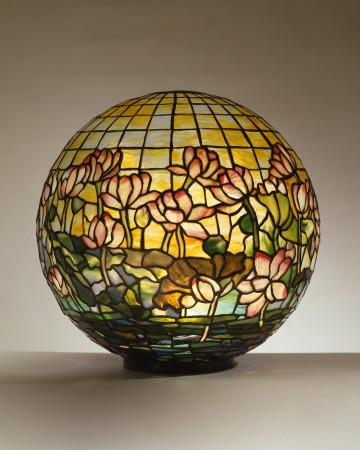This exhibition of 40 lamps conveys the beauty and complexity of the fabrication processes employed by Tiffany Studios between 1900 and 1918.
Tiffany by Design celebrated the artistry and craftsmanship of the colorful leaded glass lamps produced by Tiffany Studios between 1900 and 1918.
The exhibition examined the beautiful design and complex fabrication of 40 lamps, including chandeliers and desk, library, and hanging lamps, created by craftsmen in Tiffany Studios in New York under the direction of Louis Comfort Tiffany. The exhibition looked at every aspect of the lamps—from the beautifully crafted bronze bases and finials to the radiant colors of the leaded glass shades—to reveal what makes these designs so extraordinary.
Visitors learned how to recognize the hallmarks of a Tiffany lamp, including the deep rich color, the elegant design and motifs and the superior craftsmanship. The exhibition also presented new evidence for the vital role of women in the Tiffany firm. Recently discovered letters show that Clara Driscoll, a longtime Tiffany Studios employee, designed some of the most iconic Tiffany lampshades.
Without diminishing Tiffany’s own reputation, the exhibition endeavored to show that his artistic vision served as the inspiration and guide for all the artists and artisans who worked for him.
Tiffany by Design featured works from The Neustadt Collection. Dr. Egon Neustadt and his wife, Hildegard, began their collection with the purchase of one lamp in 1935. For the next five decades, they assembled an extensive collection of Tiffany lamps and glass. In 1970, Dr. Neustadt published The Lamps of Tiffany, which remains a standard reference on the range of styles, designs and colors of the lamps and glass created at Tiffany Studios. “In terms of the variety, number and quality of Tiffany lamps, few museums anywhere in the world can compare with The Neustadt Collection,” says Trinita Kennedy, associate curator at the Frist Art Museum. “
This exhibition was able to demonstrate precisely what sets Tiffany lamps apart from the imitations found in so many antique shops.” Signature pieces featured in Tiffany by Design include Dragonfly Library Lamp (1905–1910); Favrilefabrique Reading Lamp (ca. 1915); Daffodil Library Lamp (1900–1910); Turtleback Chandelier (ca. 1905); Lotus Pagoda Library Lamp (1895–1900); Peony Library Lamp (1905–1910) and Pond Lily Library Lamp (1900–1910).
Louis Comfort Tiffany and Tiffany Studios Based in New York City, Tiffany Studios (1902–1932) employed hundreds of master craftsmen and other skilled workers in the production of a complete range of decorative objects, including blown glass, leaded glass windows, mosaics, lamps, metalwork, enamels and ceramics. Louis Comfort Tiffany was the creative force behind this large enterprise. His personal aesthetic and artistic vision is evident in every object made at Tiffany Studios. Tiffany windows, lamps and metalwork reflect his sense of beauty and color and love of rich materials. His interest in nature and enthusiasm for the decorative potential of glass, metal and other media served as inspiration to the craftsmen and the designers who worked for him.
Tiffany’s style was influenced by the underlying geometry of the Arts and Crafts Movement and the sinuous curves and organic themes of Art Nouveau. Craftsmanship was paramount: no detail was too small, no process too complex. Tiffany Studios produced thousands of lamps in hundreds of designs, although many of them were closely related.
Examining the ways the designs and the forms were altered from object to object reveals much about the aesthetic vocabulary of Tiffany Studios. The wide range of possibilities becomes evident through a consideration of a single design, which might be realized in varying color schemes or adapted through the use of different shapes and sizes of glass.
Each piece of glass was selected and cut from a larger sheet, which was itself unique. Add to this the diversity of Tiffany’s lamp bases, and it is safe to say that no two Tiffany lamps are identical.
Organized by The Neustadt Collection of Tiffany Glass, Long Island City, New York. Nina Gray is the curator of the exhibition and the author of the exhibition catalog.

